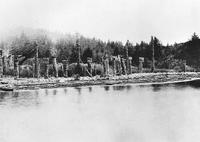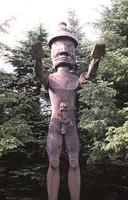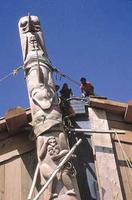Totem Poles
TOTEM POLES are the most visible example of the rich woodcarving tradition among coastal FIRST NATIONS in BC. Traditionally totem poles served as "documents" in an oral culture, proclaiming cultural identity and displaying a family's history and status. Northwest Coast peoples produced several types of totem poles, including welcome figures, traditionally carved by NUU-CHAH-NULTH (Nootka); interior houseposts, by Nuu-chah-nulth and KWAKWAKA'WAKW (Kwakiutl); doorway poles, mostly by HAIDA but also Kwakwaka'wakw, GITKSAN and NUXALK (Bella Coola); mortuary poles, by Haida, TLINGIT and, rarely, TSIMSHIAN; and memorial poles, by Haida, Tlingit, Tsimshian, Kwakwaka'wakw, Nuu-chah-nulth and Nuxalk. Shame poles, erected to ridicule a rival, were uncommon. A new type that has emerged since the 1960s is the commercial pole, commissioned by sources outside the culture for use in non-traditional settings such as museums, corporate parks or offices, schools and shopping malls. Traditionally, Coast SALISH artists did not carve free-standing totem poles, although they did produce high-relief figures on the walls of ceremonial dance houses, beam support posts and grave figures.
Each of the coastal groups has a distinct carving style. Poles are carved from western red CEDAR, with carvers looking for gigantic, straight-grained trees with a minimum of knots, rot or twisting. Pre-contact with Europeans, carving tools included knives, adzes, chisels, gouges and awls made of stone, shell and BEAVER teeth; contemporary carvers use similar metal-bladed tools and chain saws. Most poles range between 3 and 18 m in height. The tallest known 19th-century pole, from the lower NASS R (and now in the Royal Ontario Museum), stands more than 24 m. The tallest contemporary pole, located in ALERT BAY, measures 53 m. The life span of a totem pole in the damp coast CLIMATE averages 60 to 80 years, with some lasting 100 years.
Most totem poles have figures that represent the characters in mythic family or clan narratives. WOLF, EAGLE, RAVEN, FROG, BEAR, beaver, KILLER WHALE, DOGFISH, thunderbird, sisiutl (double-headed serpent), huxwhukw (cannibal bird), MOUNTAIN GOAT and human figures are common, but PLANTS, celestial bodies and landscape features also appear. It is not possible to "read" a pole by simply identifying the figures carved on it. The figures serve more as an outline of the complex story that the pole represents.
When the first European seafaring explorers ventured to the Pacific coast in the late 1700s they recorded in journals and drawings evidence of interior houseposts among the Nuu-chah-nulth, free-standing exterior carvings among the Tlingit and doorway poles among the Haida. However, the scant mention of these massive wooden carvings suggests that totem poles were not abundant. Trade in SEA OTTER pelts led to a flourishing of totem pole carving as wealthy chiefs commissioned more poles and the introduction of iron tools speeded production. This "golden age of totem poles" peaked in the mid-1860s. Then totem pole carving nearly died out as continuing contact with outsiders brought devastating epidemics, Christian indoctrination and the POTLATCH prohibition of 1884. From 1870 to 1920 the great museums of N America and Europe rushed to collect specimens of the vanishing art.
Beginning in 1925 the few remaining totem poles were recognized as being of interest to TOURISTS, so the Canadian government and the CNR undertook a restoration project on a group of SKEENA R poles. (The US government began a similar project for Alaskan poles in the late 1930s.) In the 1950s Kwakwaka'wakw carver Mungo MARTIN was hired by UBC, and later the ROYAL BC MUSEUM, to train apprentices to repair and replicate totem poles. Slowly a new generation of carvers emerged, including Bill REID and Robert DAVIDSON (Haida), Doug CRANMER and Tony and Henry HUNT (Kwakwaka'wakw), Norman TAIT (NISGA'A), Joe DAVID and Art Thompson (Nuu-chah-nulth), Nathan Jackson (Tlingit), Walter Harris (Gitksan) and many others. In the 1960s First Nations art began a revitalization that has resulted in many new totem poles and a worldwide awareness of the rich Northwest Coast carving tradition. See also ART, NORTHWEST COAST ABORIGINAL.
by Vickie Jensen
Reading: Vickie Jensen, Totem Pole Carving, 1999; Hilary Stewart, Totem Poles, 1990.



